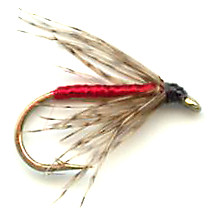Partridge & Red Soft Hackle
Soft Hackle North Country Partridge and Red Spider Wet Flies are ideal for imitating egg laying spent spinners caught in the water and dragged under the surface. They are also useful when bloodworm are on the trout's menu.

SOFT HACKLE NORTH COUNTRY SPIDER WET FLY PATTERNS. Hook size 12 14 - $US each
Soft Hackle trout fly patterns like the Partridge and Red are good at imitating spent female egg laying spinners as well as ascending pupa just before a hatch of Mayfly or Caddis. A number of female spinners, known as imagos from the Baetidae family go underwater to lay their eggs. They are extremely vulnerable to predation hungry trout during this phase of their life cycle. The most common species use this method of a egg laying are the large dark olive, medium olive, small dark olive and some iron blues.
The female spinner having crawled down on the rock or aquatic plant stem, having laid her eggs, tries to crawl back out again. Normally she is so tired and weak from the ordeal that she is swept away by the current. Abdomen colours of different species vary from yellowy brown, dull dark brown to a brick red. The Soft Hackle Partridge and Red fly pattern is a good choice for the last fly in that list.
Female spinners of many other species are also at risk of becoming food for the lurking trout and Grayling. They lay their eggs by dipping their tail broadcasting the eggs over the surface. Many of these females end up floating on the surface with their wings spread out fully spent, with no energy left to fly away from this watery grave. These bodies get dragged underwater as they go through turbulence in the River or stream system. This is when they become a tasty snack for hungry non-surface feeding fish.
The Partridge and Red soft hackled wet fly is also a good choice when there are bloodworm available for Trout and Grayling to feed upon. The lava of some species of midges (Chironomidae) that live in oxygen-poor or stagnant water are called bloodworms. Their red coloration is due to the presence of haemoglobin in their body fluids. They live either on the bottom among debris inside small tubes made of a gelatinous substance coated with silt particles or some types swim freely. They are an important source of food for many freshwater fish. There can be as many as four generations in a year. Fish your Partridge and Red bloodworm fly deep and retrieve it very slowly whilst quivering your hand.
Did you know that Large Dark Olive female spinners are red?
Yes it is true. Large Dark Olive egg laying female spinners change colour from their Dun dark olive bodies and light coloured upright wings to a red colour. They are known as Red Spinners. They also crawl beneath the water surface to lay their eggs where they become very vulnerable to predation by hungry trout. They do not die after laying their eggs. They float back up to the surface. many get trapped in the water surface tension.
If they cannot get free quickly enough they are likely to end up inside a trout's stomach. I often use the Partridge and Red Soft hackle fly as part of a team of three flies when I spot Large Dark Olive females in the water. On the point I would tie a beaded Olive Gold Ribbed Hares Ear nymph. In the middle a normal Olive Gold Ribbed Hares Ear nymph and the Partridge and Red Soft hackle on the top.
LINKEDIN READER'S COMMENT
Upstream soft Hackle spider fishing is an excellent and skill full way of fishing , all I would add it’s also practiced in Wales and Ireland, when the caddis are hatching at the change of light fished down and across on a controlled swing works a treat By Kim Tribe
LINKEDIN READER'S COMMENT
I like 2 soft hackles size 10-16 a foot apart. I tend to fish soft hackles on the swing and sometimes strip. I like them spring/summer when there's a variety of bugs hatching here in PA. Its a fun and relaxing way to fish but when you get that "tug" you'll most likely miss that fish at first or break off....throw it right back there and you got a good chance of hooking that fish. I don't go lighter than 4x and cover a lot of water. Sometimes you'll find out where that big one is and you can come back another time for him.....most water should be faster and broken water that a lot people will pass up. This is also a great technique for those holdovers that have been spooked 1000x and are in fast water. I find myself using an old bamboo and will often daydream while casting...then bam!!....kinda like swinging for steel except I guarantee a hook up!!....pretty mindless fishing and sometimes that's exactly what I want. By Jeffrey Kashuba, PE

